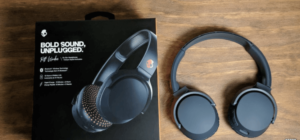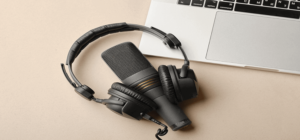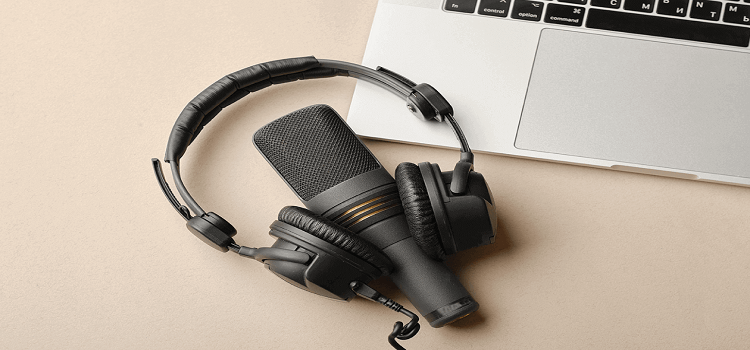As an Amazon Associate I earn from qualifying purchases.
Have you ever put on a pair of headphones and, within minutes, had a splitting headache? If so, you are not alone. Many people experience headaches when using headphones due to a variety of causes. In this article, we will look at some of the most common reasons why headphones can give you headaches and how to minimize the discomfort. We will also discuss choosing the right headphones for your needs and how to use them properly to avoid headache pain.
Why Do Headphones Give Me A Headache?
In this article, we discuss the possible causes of headaches caused by headphones and provide tips on reducing head pain when using them. We also provide information on the types of headphones that may be more suitable for those who suffer from headaches.

Identify the Causes of Headphone Headaches
Headaches caused by headphones can have both physical and psychological causes. Physical causes of headphone headaches can include wearing headphones that are too tight or loose or of poor quality. Poor quality headphones may cause a build-up of heat around the ears and head, which can lead to headache pain.
Poorly fitted headphones can cause an imbalance of sound, which can cause ears to become strained. Psychological causes of headphone headaches may include prolonged use, leading to eyestrain and headaches. In addition, some people may be more sensitive to noise, making it more challenging to focus and lead to headaches.
Choosing the correct type of headphones for your needs is essential to minimize the possibility of getting a headache when using headphones. Headphones should be comfortable and well-fitted, with a snug fit that is neither closed nor flexible.
High-quality headphones will also help to improve sound quality and prevent noise-induced headaches. It is also essential not to overuse headphones, as this can lead to eyestrain and an overstimulation of the ears. Finally, take regular breaks when using headphones to give your ears and eyes a chance to rest.
Evaluate Your Headphone Fit and Comfort
To ensure your headphones are comfortable and fitted correctly, you should consider the size of your ears and the fit of the headphones. Select headphones that are not too tight or loose, which could cause headaches and discomfort. You should also consider the materials used to make the headphones, as some may cause headaches due to their lack of breathability.
Additionally, make sure to use noise cancellation technology when possible, as this will prevent the sound from being too loud and causing headaches. When wearing headphones, taking breaks now and again is essential to give your ears a chance to rest.
This will help to prevent headaches associated with the overuse of headphones. Select the best headphones for your needs and enjoy the music without worrying about headaches.
Adjust the Volume to Avoid Hearing Damage
If the volume is too loud, it can lead to hearing damage over time. To ensure that the sound is at a level that is safe for your ears, you should use the volume control on your device. If you are unsure what volume to set it at, you can use the “low” setting on your device or even an online volume meter to ensure the sound is safe.
Taking regular breaks when using headphones is essential to ensure your ears get a chance to rest. If you listen to music for an extended period, reduce the volume and take breaks. Listening to music at a high volume for an extended period can lead to permanent hearing damage.
Therefore, it is essential to ensure you know how loud your music is and take regular breaks to keep your hearing in good condition.
Consider Earbud Alternatives
There are more earbud options than traditional headphones. Earbuds are smaller, more lightweight, and easier to use. They are perfect for people who are always on the go and want to take their music. Earbuds also offer better sound isolation than traditional headphones. This is important for those who like to listen to music at louder volumes.
Earbuds are also much more comfortable than conventional headphones. They have a better fit and don’t cause as much discomfort over long periods of use. Also, earbuds come in various styles and colours, so you can find the perfect earbuds for your class. Finally, earbuds are more affordable than traditional headphones, so they are an excellent option for those on a budget.
It is important to note that earbuds typically provide less bass than conventional headphones, so they are not the best choice for bass-heavy music. However, earbuds are an excellent alternative for those who prefer lighter music.
Try Noise-Canceling Headphones
These headphones can be used to listen to music without any other noise. Noise-cancelling headphones work by actively reducing the surrounding noise using active noise-cancellation technology. This technology produces an ‘anti-noise,’ which cancels the surrounding noise. The advantage of noise-cancelling headphones is that they allow you to focus on the music to the point where the external distractions are eliminated.
This results in a better sound quality and will enable you to enjoy the music without outside noises. Noise-cancelling headphones are fabulous for travellers, allowing you to focus on the music and relax without any external noise. They are also great for those who work in noisy environments, as they can help reduce distractions and allow them to focus on their work.
Finally, noise-cancelling headphones are fabulous for those who enjoy listening to music in private, as they provide better sound quality than regular headphones.
Take Regular Breaks From Listening With Headphones
Noise-cancelling headphones are fabulous for those listening to music without outside noise. However, taking regular breaks from using these headphones is crucial to avoid possible damage to the ears. People who use noise-cancelling headphones for an extended period may experience decreased hearing sensitivity due to long-term exposure to sound at high volumes. This can be especially dangerous for people who already have hearing problems.
Therefore, taking regular breaks from headphones is essential to avoid any potential damage to the hearing. Taking breaks can range from a few minutes to an hour or more. During these breaks, the headphones should be turned off, or the volume should be turned down. Additionally, if you are already in a noisy environment, it is better to remove the headphones altogether to avoid further damage to the ears. Listening to music with headphones is a great way to stay focused and relaxed, but taking regular breaks from headphones is essential to avoid any potential damage to the ears.
Speak to a Doctor If Symptoms Persist
Suppose you feel that you are experiencing any adverse effects on your hearing, such as decreased sensitivity, ringing in the ears, or other persistent symptoms. In that case, it is essential to speak to a doctor. Even if you take regular breaks from using the headphones, it is still possible to experience hearing damage due to extended periods of exposure to sound at high volumes. A doctor can properly diagnose and recommend the best course of treatment.
Therefore, if you feel that you are having any adverse effects on your hearing, you must speak to a doctor. Taking regular breaks from noise-cancelling headphones is necessary, but if any symptoms persist, talking to a doctor for a correct diagnosis and therapy is needed.
Conclusion
In conclusion, there are many potential causes of headaches associated with headphone use. It is critical to specify the underlying reason to manage the issue properly. Some reasons are physiological and can be addressed with the right headset design, while other reasons may require a change in listening habits or lifestyle adjustments.
If you are experiencing headaches due to headphone use, talk to your doctor or an audiologist to resolve the underlying reason and locate the best therapy option.
Amazon and the Amazon logo are trademarks of Amazon.com, Inc, or its affiliates.







